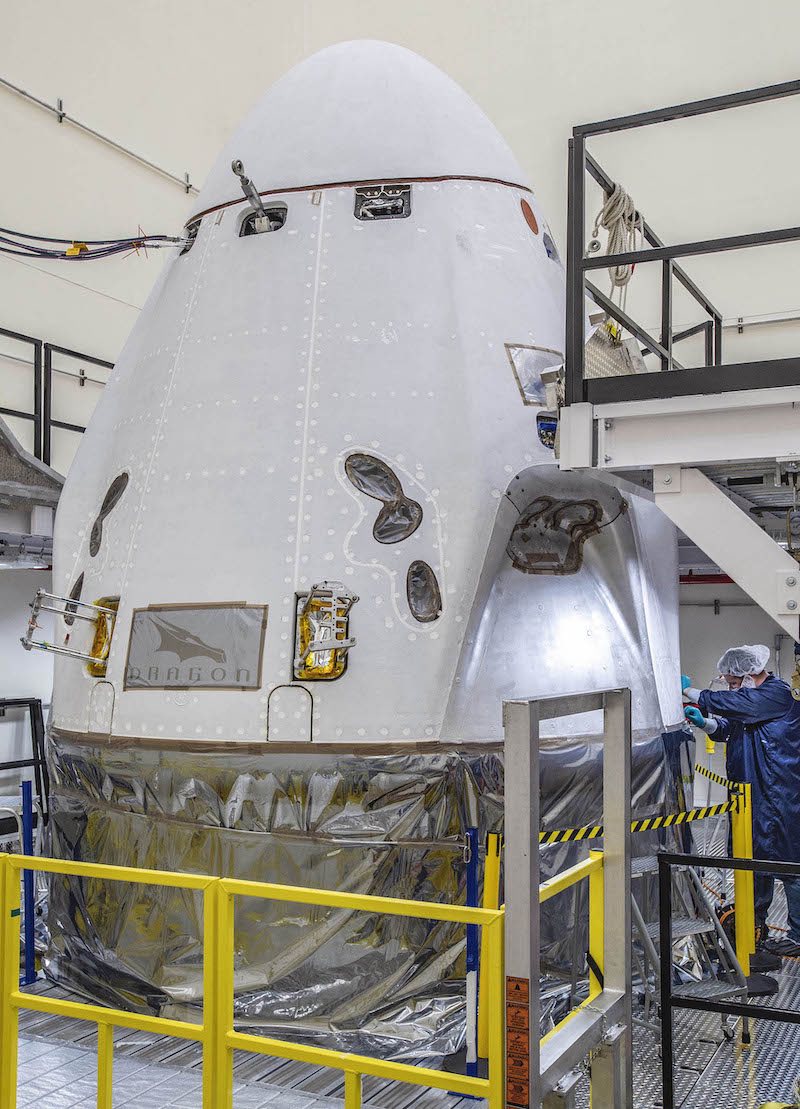
NASA said Saturday that the launch of four astronauts on SpaceX’s first operational Crew Dragon mission to the International Space Station has been delayed from Oct. 31 until “no sooner than early-to-mid November,” allowing time for SpaceX to resolve an issue with Falcon 9 rocket engines that halted a recent launch attempt with a GPS navigation satellite.
The engine concern appeared during an Oct. 2 launch attempt of a Falcon 9 rocket with a GPS satellite at Cape Canaveral, prompting computers controlling the final seconds of the countdown to abort the mission just two seconds prior to liftoff.
Elon Musk, SpaceX’s founder and CEO, tweeted after the abort that the countdown was stopped after an “unexpected pressure rise in the turbomachinery gas generator,” referring to equipment used on the rocket’s Merlin main engines. The gas generators on the Merlin 1D engines drives the engines’ turbopumps.
While the Falcon 9 launch of the U.S. Space Force’s next GPS navigation satellite remains grounded, SpaceX proceeded with the launch of a different Falcon 9 rocket Oct. 6 from a neighboring pad at NASA’s Kennedy Space Center. That mission successfully placed 60 more Starlink internet satellites into orbit.
In a statement Saturday, NASA said the Crew Dragon launch delay from Oct. 31 will allow SpaceX more time “to complete hardware testing and data reviews as the company evaluates off-nominal behavior of Falcon 9 first stage engine gas generators observed during a recent non-NASA mission launch attempt.”
The Crew Dragon mission will use the same type of Falcon 9 rocket as the GPS and Starlink launches.
NASA said it has “full insight” into SpaceX’s launch and testing data. SpaceX developed the Crew Dragon spacecraft and flies the capsule under the auspices of a multibillion-dollar contract with NASA.
“We have a strong working relationship with our SpaceX partner,” said Kathy Lueders, associate administrator of NASA’s Human Exploration and Operations Mission Directorate. “With the high cadence of missions SpaceX performs, it really gives us incredible insight into this commercial system and helps us make informed decisions about the status of our missions. The teams are actively working this finding on the engines, and we should be a lot smarter within the coming week.”

NASA commander Mike Hopkins, pilot Victor Glover, mission specialist Shannon Walker, and Japanese astronaut Soichi Noguchi will fly aboard Crew Dragon spacecraft to the International Space Station, kicking off an expedition lasting about six months. The four-person crew will blast off from pad 39A at NASA’s Kennedy Space Center.
The crew has named their Crew Dragon spaceship “Resilience.”
The reusable crew capsule was secured to its expendable unpressurized trunk section Oct. 2 at SpaceX’s processing facility at Cape Canaveral Air Force Station.
Hopkins and his crewmates will join NASA flight engineer Kate Rubins and Russian cosmonauts Sergey Ryzhikov and Sergey Kud-Sverchkov on the space station. Ryzhikov, Kud-Sverchkov, and Rubins are scheduled for launch Wednesday on a Russian Soyuz spacecraft from the Baikonur Cosmodrome in Kazakhstan.
The first operational Crew Dragon flight, named Crew-1, follows a 64-day Crew Dragon demonstration mission with NASA astronauts Doug Hurley and Bob Behnken. Hurley and Behnken launched to the space station May 30 and returned to Earth on Aug. 4 with a splashdown in the Gulf of Mexico, marking the first flight of astronauts into orbit from a U.S. spaceport since the retirement of the space shuttle in 2011.
With the test flights now in the books, SpaceX’s Crew Dragon is set to begin a series of regular crew rotation flights to the space station, ending NASA’s sole reliance on Russian Soyuz missions for crew transportation.
NASA said Saturday that the launch of the U.S.-European Sentinel-6 Michael Freilich oceanography satellite on a Falcon 9 rocket remains scheduled for Nov. 10 from Vandenberg Air Force Base in California. And a Dragon resupply mission to the space station is targeted for launch in late November or early December from Cape Canaveral Air Force Station, a delay from a previous launch date of Nov. 15, according to NASA.
“NASA and SpaceX will use the data from the company’s hardware testing and reviews to ensure these critical missions are carried out with the highest level of safety,” the space agency said Saturday.
Email the author.
Follow Stephen Clark on Twitter: @StephenClark1.



